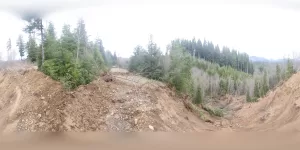Nestled in the heart of the Pacific Northwest, the North Fork Coal Creek, a tributary of the Nehalem River in Tillamook County, Oregon, is a testament to nature’s resilience and the impact of human activity. This region, once heavily logged and scarred by the infamous Tillamook Burns, has undergone a remarkable transformation over the past century.
The North Fork Coal Creek area is a part of the Tillamook State Forest, a vast expanse of land that stretches across the coastal range of Oregon. The forest is home to a diverse array of flora and fauna, including towering Douglas firs, western hemlocks, and Sitka spruces. It’s a haven for wildlife, with creatures like elk, deer, and spotted owls calling it home.
The area’s history is deeply intertwined with the timber industry. Throughout the last century, the North Fork Coal Creek area was logged multiple times. The logging practices of the past have left an indelible mark on the landscape. The Tillamook Burns, a series of devastating wildfires that occurred from the 1930s to the 1950s, further altered the forest’s composition and structure.
Despite these disturbances, the North Fork Coal Creek area has shown remarkable resilience. Today, the forest is a mix of different age classes, with patches of old-growth standing alongside younger, second-growth stands. This mosaic of habitats contributes to the area’s rich biodiversity.
However, the legacy of past forestry practices is still evident. The closure of one road and the expansion of another, the logging of one stand and the preservation of the other, have moved wildlife to narrow corridors of forest where human activity is limited. The impact of land management decisions over time is noticeable—a new sign here, a widened and cleared path there, a salmon habitat restoration project nearby. Meanwhile, the majority of the surrounding forest continues to function as an active timber operation, so you’ll run into log trucks during regular business hours.
The North Fork Coal Creek area serves as a living laboratory, providing valuable insights into the dynamics of forest ecosystems and the effects of human activities. It underscores the importance of sustainable forestry practices that maintain the health and diversity of forests while also meeting economic needs.
One of the most striking features of the North Fork Coal Creek area is a landslide off the North Fork Coal Creek Road. This landslide, located at the headwaters of a tributary, was likely triggered by unstable road cuts and repeated cycles of wet springs and dry summers. The young, new growth vegetation in the area, with their shallow root systems, may have also contributed to the slope failure. The landslide has significantly altered the landscape.


As we look to the future, the North Fork Coal Creek area stands as a testament to nature’s resilience and a reminder of the importance of responsible forest management. It’s a place where the past informs the present, and where lessons learned can guide us towards a more sustainable future.
I’ll be documenting a series of hiking trips around the area this summer, ranging in difficulty, if you have a location you’d like me to visit let me know by emailing the editor @ tillamookcountypioneer.net


